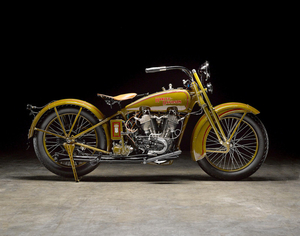1927 Harley-Davidson 74ci Model JD, Engine no. 27JD5213
1927 Harley-Davidson 74ci Model JD
Engine no. 27JD5213
• Recent restoration
• New oil/gas tanks made by Replicant Metals
• Aluminum pistons, stainless steel valves and new exhaust
1909 marked the appearance of Harley-Davidson's first v-twin, though it was not until the adoption of mechanically-operated inlet valves in 1911 (replacing the 'atmospheric' type inherited from the single) that production really took off. Known by the sobriquet 'pocket valve', this 'F-head' (inlet-over-exhaust) engine - built in both 61ci/1,000cc and 74ci/1,200cc capacities - would remain in production for the next 20 years. The Harley single's transmission arrangements - direct drive by means of a leather belt - were continued at first on the twin, but the need to make better use of the engine's power characteristics, particularly for sidecar pulling, prompted the introduction of a two-speed rear hub for 1914, by which time chain drive and a proper clutch had been adopted. Later that same year a conventional, three-speed, sliding-gear transmission with 'step starter' was introduced on the top-of-the-range version of the twin which, with full electrical equipment, was listed from now on as the Model JD. Periodically revised and up-dated, the model had gained a front brake, a stronger fork and pumped lubrication by the time production ceased in 1929
The Harley-Davidson Motor Company has never been one to take chances and throw wholly untested motorcycles into the market. Instead they have traditionally been a conservative company of honor bound to careful evolution. The year 1925 stood as a breakthrough year as they left behind the loop frames that served them well since 1903, and brought many other modernizations to their family of motorcycles including smaller-diameter wheels. The next few years saw only incremental improvements. Hailed as the most significant innovation for 1927, Harley-Davidson introduced a new distributor-less ignition system that used a circuit breaker. While one spark plug fired on compression, the second plug was also firing but during the exhaust stroke producing a "wasted spark". It remained a hallmark into the 1959 model year. Reportedly the Juneau Street company sold 9,691 JDs in 1927, a not insignificant number, quoted retail price $320.
This 1927 Harley-Davidson JD features the robust 74 cubic inch V-twin signature engine with a 3-speed chain drive transmission, and is fitted with electric lights. It has been fully restored, the seller starting with a non-runner, with a substantial number of invoices in the history file. The JD would make an excellent motorcycle to participate in vintage touring and occasional recreational use. The vendor reports that it will fire on the first kick, and that it is in excellent mechanical condition and ready to travel the roads again as it did 85 years ago.
View it on
Sale price
Estimate
Time, Location
Auction House
1927 Harley-Davidson 74ci Model JD
Engine no. 27JD5213
• Recent restoration
• New oil/gas tanks made by Replicant Metals
• Aluminum pistons, stainless steel valves and new exhaust
1909 marked the appearance of Harley-Davidson's first v-twin, though it was not until the adoption of mechanically-operated inlet valves in 1911 (replacing the 'atmospheric' type inherited from the single) that production really took off. Known by the sobriquet 'pocket valve', this 'F-head' (inlet-over-exhaust) engine - built in both 61ci/1,000cc and 74ci/1,200cc capacities - would remain in production for the next 20 years. The Harley single's transmission arrangements - direct drive by means of a leather belt - were continued at first on the twin, but the need to make better use of the engine's power characteristics, particularly for sidecar pulling, prompted the introduction of a two-speed rear hub for 1914, by which time chain drive and a proper clutch had been adopted. Later that same year a conventional, three-speed, sliding-gear transmission with 'step starter' was introduced on the top-of-the-range version of the twin which, with full electrical equipment, was listed from now on as the Model JD. Periodically revised and up-dated, the model had gained a front brake, a stronger fork and pumped lubrication by the time production ceased in 1929
The Harley-Davidson Motor Company has never been one to take chances and throw wholly untested motorcycles into the market. Instead they have traditionally been a conservative company of honor bound to careful evolution. The year 1925 stood as a breakthrough year as they left behind the loop frames that served them well since 1903, and brought many other modernizations to their family of motorcycles including smaller-diameter wheels. The next few years saw only incremental improvements. Hailed as the most significant innovation for 1927, Harley-Davidson introduced a new distributor-less ignition system that used a circuit breaker. While one spark plug fired on compression, the second plug was also firing but during the exhaust stroke producing a "wasted spark". It remained a hallmark into the 1959 model year. Reportedly the Juneau Street company sold 9,691 JDs in 1927, a not insignificant number, quoted retail price $320.
This 1927 Harley-Davidson JD features the robust 74 cubic inch V-twin signature engine with a 3-speed chain drive transmission, and is fitted with electric lights. It has been fully restored, the seller starting with a non-runner, with a substantial number of invoices in the history file. The JD would make an excellent motorcycle to participate in vintage touring and occasional recreational use. The vendor reports that it will fire on the first kick, and that it is in excellent mechanical condition and ready to travel the roads again as it did 85 years ago.



